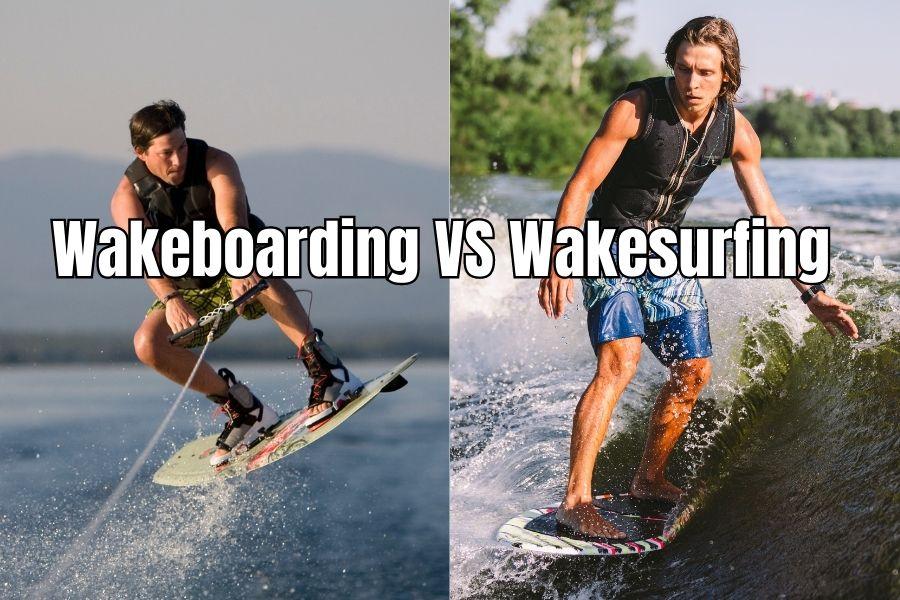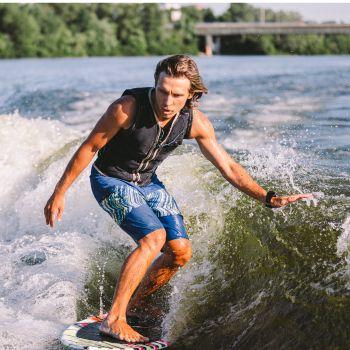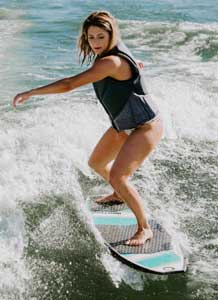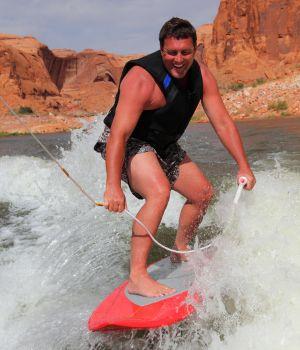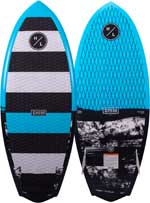Wakeboarding and wakesurfing share similarities but have distinctive characteristics that set them apart. Below, we explain the key differences between these 2 board sports and offer valuable tips for wakeboarders venturing into wakesurfing…
Wakesurfing: Riding the Endless Wave
Wakesurfing is the art of surfing the wake created by a boat. Unlike traditional surfing, wakesurfers ride a smaller, specialized board close to the boat, without the need for a towrope once they’re up and riding.
This is because the wake’s size and shape provide enough push to keep the rider gliding along indefinitely.
This allows riders to perform various tricks, jumps, and maneuvers in the boat’s relatively calm wake. It’s a sport that often emphasizes style, creativity and a laid-back vibe.
Wakeboarding: Skimming the Surface
Wakeboarding, on the other hand, involves riding a narrower board with foot bindings while being towed by a boat. The rider uses the boat’s wake to perform tricks, jumps and aerial maneuvers, often reaching impressive heights. Unlike wakesurfing, wakeboarders are continuously towed by a rope, which provides the necessary speed and tension to execute tricks.
In addition, wakeboarding involves a combination of balance, strength, timing and coordination. For instance, riders use the boat’s wake to launch themselves into the air, performing different stunts, spins and flips before landing back on the water.
Tips for Wakeboarders Learning to Wakesurf
If you’re a seasoned wakeboarder intrigued by the prospect of wakesurfing, transitioning to this new sport can be a breeze. Here are 6 simple tips to help you start surfing:
1. Select the Right Wakesurf Board: When it comes to wakesurfing, the type of surfer you use can make learning easier – or more difficult. Opt for a larger, more stable board with a grippy deck pad. These features will give you the stability you need as you get accustomed to riding the wake without being towed.
2. Body Positioning: Unlike wakeboarding, where you’re pulled by a rope, wakesurfing requires you to rely on the boat’s wake for propulsion. Keep your knees slightly bent and your weight centered over your board. Gradually shift your weight forward or backward to adjust your speed and position on the wave.
3. Start Slow: As a wakeboarder, you might be used to a faster pace. However, wakesurfing is all about finesse and finding the sweet spot in the wake. Plus, driving the boat at a slower speed (typically around 10 mph) generates a larger wake.
4. Practice the “Ropeless” Technique: To get the hang of wakesurfing, practice surfing without the rope. After you feel more steady on your feet, keep the rope hanging loosely rather than taught. Over time, as you gain more confidence, you can throw the rope into the boat and surf “ropeless”.
5. Perfect Your Turns: Wakesurfing offers the opportunity to perform stylish turns and carves on the wake’s face. Use your back foot to apply pressure and initiate turns while keeping your body centered over the board.
6. Safety First: Always wear a life jacket while wakesurfing and ensure that there’s a spotter on board to keep an eye on you.
Q&A:
Q: Can I use my wakeboarding board for wakesurfing?
A: Wakesurfing boards are specifically designed for the sport and differ from wakeboarding boards. For example, surfers have a wider, lightweight design that enables them to float better on top of the water.
Q: Is wakesurfing more beginner-friendly than wakeboarding?
A: Wakesurfing is often considered more beginner-friendly due to the slower speeds and close proximity to the boat, allowing for easier communication with the driver. However, wakeboards have bindings which keep your feet securely in place – making people feel more stable.
Q: How do I generate enough speed to wakesurf without being towed?
A: The boat’s speed and wake shape play a crucial role in generating enough push for wakesurfing. Start the boat slow, around 9 to 11 mph and weight one side of the boat (either with people, ballast or a wake shaper) to increase the size of the wave. If you need to, gently place more pressure on your front foot to speed up your board.
In Summary:
Wakesurfing provides the freedom of gliding on the wake without being towed, emphasizing creativity and style, while wakeboarding offers the opportunity for impressive aerial tricks and maneuvers with the help of a tow rope.
If you’re a wakeboarder new to wakesurfing, keep in mind that you’ll want to focus more on balance and body position. Learn to use your body to speed up, slow down or turn your board instead of pulling on the rope.

